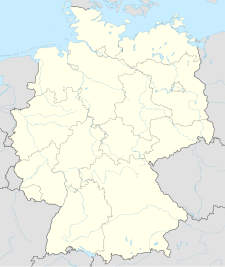Marcianosuchus
| Marcianosuchus Temporal range: Middle Triassic,
| |
|---|---|
| Scientific classification | |
| Domain: | Eukaryota |
| Kingdom: | Animalia |
| Phylum: | Chordata |
| Class: | Reptilia |
| Clade: | Archosauromorpha |
| Clade: | Archosauriformes |
| Clade: | Eucrocopoda |
| Genus: | †Marcianosuchus Sues, Spiekman & Schoch, 2024 |
| Species: | †M. angustifrons
|
| Binomial name | |
| †Marcianosuchus angustifrons Sues, Spiekman & Schoch, 2024
| |
Marcianosuchus is an extinct genus of eucrocopodan archosauriforms from the Middle Triassic Röt Formation of Germany. The genus contains a single species, M. angustifrons, known from a partial disarticulated skeleton. Marcianosuchus represents the first non-archosaurian archosauriform named from Central Europe.
Discovery and naming[edit]
The Marcianosuchus holotype specimen, SMNS 91318, was discovered in 1972 by Rupert Wild in talus deposits of the retired Kössig quarry, representing outcrops of the Röt Formation (Buntsandstein Group) near Ebhausen in Calw district of Baden-Württemberg, Germany. The specimen consists of an associated, generally disarticulated, skeleton of a single individual. Known material includes several bones of the skull and lower jaws, teeth, pectoral and pelvic girdles, humeri, femora, an incomplete tibia and probable fibula, assorted autopodial bones, cervical, dorsal, and caudal vertebrae, associated osteoderms, ribs, and gastralia.[1]
In 2024, Sues, Spiekman & Schoch described Marcianosuchus angustifrons as a new genus and species of archosauriforms based on these fossil remains. The generic name, Marcianosuchus, combines a reference to the Black Forest near the type locality (its Latin name, used by historian Ammianus Marcellinus in the 4th century, is "Marciana silva", meaning "border forest") with the Greek σοῦχος ("suchus"), after Sobek, the crocodile-headed ancient Egyptian deity. The specific name, angustifrons, combines the Latin words "angustus", meaning "narrow", and "frons", meaning "forehead", after the holotype skull's narrow frontal region.[1]
Marcianosuchus is the only non-archosaurian archosauriform currently known from Germany's Buntsandstein Group and Central Europe as a whole.[1]
Description[edit]

Marcianosuchus was a fairly small archosauriform. The holotype individual was likely not fully mature when it died, so would have been able to grow larger. Its femur was close to 115 millimetres (4.5 in), similar to the 127 millimetres (5.0 in) femur of the euparkeriid "Turfanosuchus" shageduensis. The longest known femur of Euparkeria is only 65.5 millimetres (2.58 in) long.[1]
Marcianosuchus has a body plan very similar to the similarly aged Euparkeria from South Africa. With the euparkeriid-like Dorosuchus from Russia, Marcianosuchus presents a generally skeletal morphology comparable to the archosaur plesiomorphic condition.[1]
Several generally rectangular osteoderms were found in association with the other skeletal elements of Marcianosuchus. These were interpreted as likely forming a paired row along the midline of the back, as in euparkeriids.[1]
Classification[edit]
In their phylogenetic analysis, Sues, Spiekman & Schoch (2024) recovered Marcianosuchus as a basal member of the archosauriform clade Eucrocopoda, in a polytomy with Dorosuchus outside of the Euparkeriidae. Their results are displayed in the cladogram below:[1]
Palaeoenvironment[edit]
Marcianosuchus is known from the Röt Formation of Germany, which dates to Anisian age of the beginning of the Middle Triassic period.[1] Other fossils from the formation include those of selachian fishes, temnospondyls such as Eocyclotosaurus, and reptiles including Amotosaurus Cymatosaurus, Sclerosaurus, and ctenosauriscids.[2][3][4][5]
References[edit]
- ^ a b c d e f g h Sues, Hans-Dieter; Spiekman, Stephan N. F.; Schoch, Rainer R. (2024). "Osteology and phylogenetic relationships of a new archosauriform reptile from the Middle Triassic (Anisian) of Germany". Journal of Vertebrate Paleontology. e2357326. doi:10.1080/02724634.2024.2357326.
- ^ Fraser, N. C.; Rieppel, O. (2006). "A new protorosaur (Diapsida) from the Upper Buntsandstein of the Black Forest, Germany". Journal of Vertebrate Paleontology. 26 (4): 866. doi:10.1671/0272-4634(2006)26[866:ANPDFT]2.0.CO;2.
- ^ Rieppel, O (1999). "Variation of cranial characters in Cymatosaurus "gracilis" Schrammen 1899 (Reptilia, Sauropterygia), and its implications for systematics". Paläontologische Zeitschrift. 73 (3–4): 369–375. doi:10.1007/BF02988047. S2CID 84238070.
- ^ Hans-Dieter Sues and Robert R. Reisz (2008). "Anatomy and Phylogenetic Relationships of Sclerosaurus armatus (Amniota: Parareptilia) from the Buntsandstein (Triassic) of Europe". Journal of Vertebrate Paleontology. 28 (4): 1031–1042. doi:10.1671/0272-4634-28.4.1031. S2CID 53967912.
- ^ Richard J. Butler; Stephen L. Brusatte; Mike Reich; Sterling J. Nesbitt; Rainer R. Schoch; Jahn J. Hornung (2011). "The sail-backed reptile Ctenosauriscus from the latest Early Triassic of Germany and the timing and biogeography of the early archosaur radiation". PLOS ONE. 6 (10): e25693. Bibcode:2011PLoSO...625693B. doi:10.1371/journal.pone.0025693. PMC 3194824. PMID 22022431.




